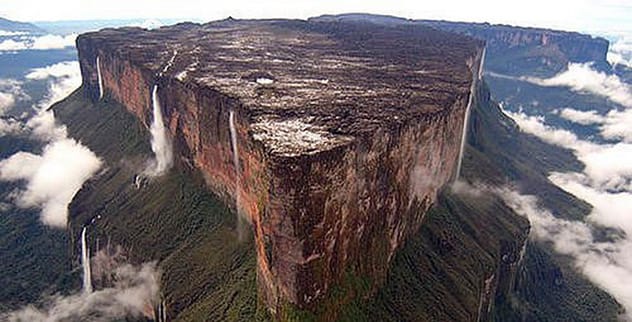The world is full of incredible places that seem to defy imagination. Ready to explore some of the most unique and amazing spots our planet has to offer? Let’s dive into a list of ten extraordinary destinations that will spark your wanderlust and leave you in awe.
1. The Door to Hell, Turkmenistan
Imagine a fiery crater burning continuously for over three decades. That’s the Door to Hell, located in Darvaza, Turkmenistan. This 70-meter wide crater was created in 1971 when geologists drilling for gas accidentally collapsed an underground cavern.
To prevent poisonous gas from escaping, they set it alight, expecting it to burn out in a few days. However, the gas supply was much larger than anticipated, and the crater continues to burn fiercely to this day. A truly unforgettable sight!
2. Mount Roraima, South America
Mount Roraima is a stunning tabletop mountain, boasting sheer 400-meter high cliffs on all sides. Located in South America, accessing it is no easy feat, with only one relatively easy route via a natural staircase-like ramp on the Venezuelan side.
The summit experiences almost daily rainfall, creating a unique, nutrient-poor landscape on the sandstone surface. This environment fosters unique species, including carnivorous pitcher plants, and some of the world’s highest waterfalls cascade down its sides.

3. Meteor Crater, Arizona, USA
Located near Winslow, Arizona, the Meteor Crater is a well-preserved meteorite impact site. It formed approximately 50,000 years ago when a nickel-iron meteorite, about 50 meters across, struck the Colorado Plateau at immense speed.
During that era, the climate was cooler and damper, and the area was inhabited by woolly mammoths and giant ground sloths. This crater offers a fascinating glimpse into Earth’s dramatic past.

4. Great Dune of Pyla, France
Europe might not be known for its deserts, but the Great Dune of Pyla is an exception. As Europe’s largest sand dune, it measures 3km long, 500m wide, and 100m high. Surprisingly, it formed in a forest, creating a striking contrast.
The dune’s steep side faces the forest, making it a popular paragliding spot. From the top, you can enjoy spectacular views of the sea and the surrounding forest.

5. Socotra Island, Yemen
Described as one of the most alien-looking places on Earth, Socotra Island is truly unique. Its isolation and harsh climate have led to the evolution of a third of its plant life being found nowhere else.
One of its most iconic species is the Dragon’s Blood Tree, with its umbrella shape and red sap. The island is also home to numerous endemic birds, spiders, and coral reef species, making it a biodiversity hotspot in the Arabian Sea and a designated World Heritage Site.

6. 83-42, Northern Greenland
83-42 is believed to be the northernmost permanent point of land on Earth. This tiny island, measuring only 35m by 15m and 4m high, lies about 400 miles from the North Pole.
Discovered in 1998, it surpassed the previous record holder, ATOW1996. Lichens found on this gravel bar suggest it’s not just a temporary formation, though few have ever set foot on it.

7. Rotorua, New Zealand
Rotorua, located on New Zealand’s North Island, is renowned for its geothermal activity. Geysers, such as the Pohutu Geyser, and boiling mud pools dot the landscape, creating a surreal environment.
The city’s unique “rotten eggs” aroma comes from the sulphur compounds released by this geothermal activity. Rotorua is also a hub for adventure activities and a cultural heartland for the Māori people.

8. Don Juan Pond, Antarctica
With a salinity level exceeding 40%, Don Juan Pond is the saltiest body of water on Earth. Despite Antarctic temperatures often dropping to -30°C, it never freezes due to its extreme salt concentration.
This small, shallow lake is named after the pilots who first investigated it in 1961. Its salinity is 18 times higher than seawater, surpassing even the Dead Sea, which is only 8 times saltier.

9. Iceberg B-15, Antarctica
Iceberg B-15 was the largest iceberg ever recorded, boasting an area of 3,100 km², larger than Jamaica. It broke off from the Ross Ice Shelf in March 2000.
Over the years, it fragmented, with one large piece (B-15a) colliding with a glacier in 2005, causing significant damage. Despite its breakup, parts of B-15 persist, with the largest remaining section still covering 1,700 km².

10. Guaíra Falls (defunct), Brazil/Paraguay
Once the largest waterfall on Earth in terms of total volume, Guaíra Falls was located on the Paraná River. An astounding 1,750,000 cubic feet of water cascaded over it each second.
Sadly, the falls were flooded in 1982 due to the construction of the Itaipu Dam, which now supplies 90% of Paraguay’s and 19% of Brazil’s power, including major cities like Rio de Janeiro and São Paulo.

Conclusion
From fiery craters to alien islands and colossal icebergs, our planet is full of unique and amazing places. Each of these destinations tells a story of natural forces, isolation, and adaptation. Exploring these wonders reminds us of the incredible diversity and beauty of our world.
Which of these places would you most like to visit? Leave your comment below!










